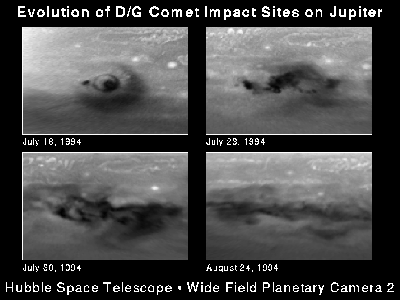
Hubble Space Telescope's Observations of Comet SL9

Click here to see the Hubble Space Telescope's view of Jupiter during one of the impacts.
Hubble Space Telescope
The telescope's science instruments will provide extremely high-resolution
images and spectral data on the Jupiter environment before, during and after
the comet collision. Astronomers will study the evolution and other physical
changes in the comet prior to impacts. This will provide detailed information
about the impact times, comet fragment sizes and changes in the dusty "coma"
region around the fragments. Though impacts are predicted to occur on the far
side of Jupiter, astronomers hope HST can image the resulting fireball that
might be visible on the limb of the planet. After the collisions, HST will
look for changes in Jupiter's atmosphere, changes on its satellites, effects
on the magnetosphere and any development of a new ring system.
HST will perform a comprehensive and simultaneous mapping of Jupiter's upper
atmosphere in the aftermath of the impacts. Hubble's high resolution might
uncover atmospheric changes that are below the visible-light resolution limit
of ground-based telescopes. Researchers will look for shock waves that might
propagate across the Jovian atmosphere; new cloud features that might form at
the impact sites; and the behavior of cometary ices and dust injected into
Jupiter's upper atmosphere. At least 100 orbits will be used. Observations will
be made by six teams from a variety of universities.
Public Affairs contacts:
Ray Villard
Hubble Space Telescope Science Institute
Baltimore, Md.
(410) 338-4514
Jim Elliott
NASA Goddard Space Flight Center
Greenbelt, Md.
(301) 286-6256
Hubble Space Telescope Observation Plans
Hubble Space Telescope Observations
- HST Daily Report (July 12, 1994).
- HST Daily Report (July 14, 1994).
- HST Daily Report (July 15, 1994).
- HST Daily Report (July 18, 1994).
- HST Daily Report (July 19, 1994).
- HST Daily Report (July 20, 1994).
- HST Daily Report (July 21, 1994).
- WFPC-2 Mission Status Report (August 5, 1994).
- Hubble Space Telescope Daily Report (August 24, 1994).
- Hubble Space Telescope Daily Report (August 25, 1994).
- Hubble Observations Shed New Light on Jupiter Collision.
- Summary of Comet Day Poster Session (Mark Boslough)
- Hubble Space Telescope Daily Report (February 14, 1995)
- Hubble Space Telescope Daily Report (February 21, 1995)
- Hubble Space Telescope Daily Report (March 6, 1995).
- Hubble Space Telescope Daily Report (March 7, 1995).
- Hubble Space Telescope Daily Report (March 10, 1995).
- Hubble Space Telescope Daily Report (April 7, 1995).
- Hubble Space Telescope Daily Report (April 17, 1995).
- Hubble Space Telescope Daily Report (April 18, 1995).
- Hubble Space Telescope Daily Report (May 3, 1995).
- Recent Hubble Observations of Jupiter (June 13, 1995).
- Hubble Detects Comets Beyond Neptune (NASA - June 14, 1995).
- Hubble Space Telescope Daily Report (August 28, 1995).
- Hubble Space Telescope Daily Report (September 8, 1995).
- Hubble Space Telescope Daily Report (September 27, 1995).
- Hubble Space Telescope Daily Report (October 5, 1995).
- Hubble Space Telescope Daily Report (October 6, 1995).
- Hubble Space Telescope Daily Report (October 10, 1995).
li>Hubble Observes Comet SL9 Effects on Jupiter (February 22-23, 1996).
Images
- Hubble Image of Comet Shoemaker-Levy (July 1, 1993).
- Hubble Image of Comet Shoemaker-Levy (July 1, 1993).
- Hubble Image of Comet SL9 (March 1994).
- Hubble Images of Comet Shoemaker-Levy (July 1993 - March 1994).
- Hubble Image of Jupiter and Io (May 18, 1994).
- Hubble Composite of Comet and Jupiter (May 17-18, 1994).
- Hubble Image of Jupiter's Aurora (July 13, 1994).
- Hubble Image of Fragment A Impact (July 16, 1994).
- Hubble Image of Fragment A Impact (July 16, 1994).
- Hubble Image of Fragment A Plume (July 16, 1994).
- Hubble Images of Fragment A Plume (enhanced by SDB Systems, July 16, 1994).
- Hubble Image of Fragments A, C & E (July 17, 1994).
- Hubble Image of Fragments A, C & E (July 17, 1994).
- Hubble Image of Fragment ?? Impact (enhanced by SDB Systems, July, 1994).
- Hubble Color Image of Fragment G Impact (July 18,
1994).
- Hubble Color Image of Fragment G Impact (July 18, 1994).
- Hubble Image of Fragment G Impact (July 18, 1994).
- Hubble Images of Fragment G Impact (July 18, 1994).
- Hubble Images of Fragment G Plume (July 18, 1994).
- Hubble Images of Fragment G Impact (enhanced by SDB Systems, July 18, 1994).
- Hubble Images of Fragment G Impact (July 18-23, 1994).
- Hubble Image of Fragment K Impact (July 19, 1994).
- Hubble Image of Fragment K Impact (July 19, 1994).
- Hubble Image of Fragment K Impact (July 19, 1994).
- Hubble Image of Fragment Q2 Impact (July 20, 1994).
- Hubble Image of Fragment Q2-1 Impact (July 20, 1994).
- Hubble Image of Fragment P & Q (July 20, 1994).
- Hubble Images of Fragment P-Q Complex (July 1, 1994 - July 20, 1994).
- Hubble Image of Fragment BDGLNQ12R Impacts (July 21, 1994).
- Hubble Image of Fragment DEFGNQ12R Impacts (July 21, 1994).
- Hubble Images of Fragment W Impact (July 22, 1994).
- Hubble Image of Jupiter (July 22, 1994).
- Hubble Color Image of Fragment A Impact (July 22, 1994).
- Hubble Images of Fragment A Impact (July 22, 1994).
- Hubble Images of Fragment ACE Impact (July 17-29,
1994).
- Hubble Image of Fragment DG Impacts (July 18 - August 24, 1994).
- Hubble Color-Composite Maps of Jupiter (July 15 - August 24, 1994).
- Hubble Image of Jupiter (February 13, 1995).
- Hubble Image of Jupiter (February 13, 1995).
- Hubble Images of Jupiter (October 4-6, 1995).
 Comet Shoemaker-Levy Home Page
Comet Shoemaker-Levy Home Page
For suggestions or additions to the this page, please contact:
Ron Baalke
ron@jpl.nasa.gov



